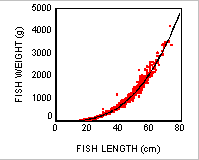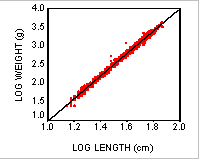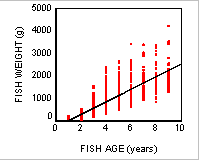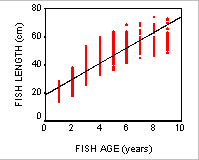An otolith class project
Project explanation, materials and steps for biological sampling, age determination and data analysis.
On this page
Project overview
This otolith science project focuses on analyzing a group of fish and calculating their rate of growth. It's targeted to a class of high school students or to individuals preparing an exhibit for a science fair. Skills used in this project include:
- hands-on biology
- data collection
- data interpretation
- computer skills
This type of activity exposes students to a range of scientific activities and represents a genuine portion of the job of a fisheries biologist.
Project materials
For this project you'll need materials including:
- clay and vegetable oil
- measuring boards or rulers
- at least 1 balance for weights
- surgical type gloves (optional)
- fish knives and forceps for otolith removal
- about 30 whole or gutted fish of various sizes
- dissecting microscope(s) for age determination
- computer program capable of simple graphs or charts
- alternatively, you can use graph paper
If purchasing whole fish is too expensive, you can use the heads alone. Fish processors and seafood markets will often save heads for teachers at no cost if you give them appropriate lead time.
Biological sampling
For biological sampling, have students work in pairs. Then:
- weigh and measure each fish or head (a minimum of 2 fish per pair)
- record lengths from the tip of the nose to the fork in the tail (or the tip of the tail if there is no fork)
- if you're using just the heads, the length is the tip of the nose to the back of the gill flap
- cut open each head and remove the otoliths
This should take approximately 1 hour.
You can store dried otoliths until the next class, or if there's sufficient time, they can be aged immediately.
Age determination
Have students work in pairs to prepare and age each pair of otoliths.
Once completed, each student should circulate to the other stations to examine the other prepared otoliths. This allows them to familiarize with a broader range of otoliths and preparations.
When they return to their own otoliths, they should re-examine them, and revise their ages, if needed. Once satisfied, they should calculate an average age for each pair of otoliths (each fish). This is because the 2 otoliths may or may not result in the same ages.
Data collection
On the class board, compile the class data in 3 columns. In each, write down each fish's:
- average age
- length
- weight
The data for a given fish must be all in the same row.
Have your students copy down the columns and numbers for all the fish. These numbers make up the data for the following class.
This should take approximately 1 hour.
Data analysis
The data for any 1 fish may or may not be representative of other fish. It may not even be correct. But when you examine a sufficient number of fish, the overall trend is much more likely to be correct.
Working individually, the students should enter the data into a computerized spreadsheet or charting program. The data should be entered as they were recorded on the board. That is:
- 1 row per fish
- 3 columns, 1 each for:
- length
- weight
- age
Using a spreadsheet program or graph paper, prepare graphs, including:
- fish length versus fish weight
- fish length versus fish weight after log transformation
- fish weight versus fish age
- fish length versus fish age
Fit regressions (linear or exponential) to each of the graphs as part of any spreadsheet. Alternatively, lines can be drawn through the data by eye. Then, ask your students to interpret the results.
Interpreting results
The weight versus length graph indicates that the weight of the fish increases much more rapidly than does the length.
The length versus weight log transformation graph shows that the relationship is exponential (just like that of bank interest).
The slope of the length versus age graph indicates the growth rate of the sample of fish.
The spreadsheet will display the value for the slope when the regression is fitted. If it doesn't, you can calculate the slope as the:
- 'rise over run' of the fitted line or
- (greatest length on line minus smallest length on line) divided by the (greatest age on line minus the youngest age on line)
This growth rate is the average expected growth of your fish each year. The fact that the growth rate in weight is curved indicates that its growth is much faster, and increases exponentially compared to that of length.
Questions for your student
Have your students calculate the expected length of the fish at a different age. For example, if they calculate at an age of 10 years, they should multiply the age (10) by the slope and add it to the intercept value from the regression.
You can also ask your students:
- How large would the fish be at 100 years of age?
- Why is it dangerous to predict beyond the range of your data?
The correct answer is that the relationship between fish length and age could change at non-observed ages.
The data analysis portion of this project should take approximately 1 hour.
Related links
- Otoliths removal and ageing
- Date modified:



